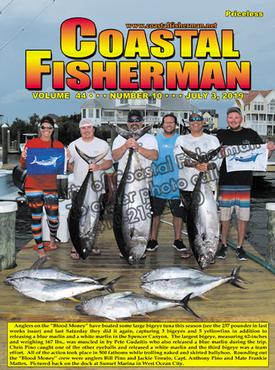


Article by Capt. Steve Katz
 The Green Wire
The Green Wire
Part II
Following up from last week, the green jacketed wiring on boats is an important wire for many systems, Last week, we reviewed the green safety ground on the alternating current (AC) powered circuits. That green wire helps to protect us from getting shocked if there is a fault in the boats wiring or equipment.
Another important, but separate, use of green jacketed wiring is for bonding of the boat’s underwater metals. This is for the protection of hardware that extends below the hull into the seawater. A complete bonding system is an electrical interconnection of underwater metallic components, such as through hulls, struts, rudders, shafts and zincs.
Without a bonding system, the combination of individual dissimilar metals in a common electrolyte (saltwater) will create a “battery” with some metals acting as an anode and some metals acting as a cathode.
A small electrical current is then created between the anode and cathode, where electrons leave the anode and travel to the cathode.
Depending on what metals are nearby and their natural voltage potential determines which is the anode and which is the cathode.
Luckily for most boaters, this problem is solved by using a sacrificial anode. These are most commonly a zinc, but could be aluminum or magnesium, depending on the boat and water. They act as an anode for most common underwater metals used on a boat. The sacrificial anode (zinc) will slowly “wear” or lose electrons to protect the other underwear metals from becoming an anode. This Galvanic corrosion is a DC electric system not to be confused with what boaters refer to as a stray current, which is an AC or alternating current electrical system that also can cause similar corrosion problems on a boat.
One popular mistake boaters often make is that they think if one zinc is good, more is better. This is not the case. A properly designed bonding system will have the proper underwater voltage potential. Too little or too much sacrificial anode (zinc) can cause problems with galvanic corrosion.
If your zinc and bonding system are designed and working properly, the zinc should appear to slowly wear away. In this geographic area, replacement of the zinc once or twice a season is not uncommon, though each boat is different. If you notice that your zinc is not wearing away at all or only lasts a few weeks, that is a sign that something may be wrong with your bonding system, your on-board electrical system or your dock neighbors’ electrical system.
How can a nearby boat cause galvanic corrosion on my boat? Remember that green safety grounding wire from last weeks article? The green safety grounding wire in a marina is a common wire that connects all boats to each other and to the ground on land at the source of power. The shore power cords and circuit breakers between land and each boat always keep the green safety wire connected, even if the circuit breaker is off.
A boat bonding system, that green wire that connects underwater metals, is also connected at only a single point to the boats safety ground (per ABYC standards). Do you see where this is going? A nearby boat that has a bad electrical system or bad bonding system, worn out zincs, etc., can send DC electricity through the dock green safety ground wiring and into your boats safety ground and finally into your boats bonding system. Note, the green safety ground in the shore power supply system can carry both AC and DC power at the same time.
Since you can’t disconnect the green safety ground, how can you block this DC electricity? A galvanic isolator! Many boats come equipped with this device when they are built. A galvanic isolator blocks most DC power that can sneak into the safety ground, while at the same time keeping you safe by maintaining the shore power green wire safety ground circuit to the dock and land. If you are not sure if your boat has a galvanic isolator, you can look at your boats wiring. The galvanic isolator needs to be connected as close to the shore power input as possible before any other electrical connections to the green safety wire are made, most often inside the main electrical panel or somewhere just behind the shore power inlet.
These galvanic isolators can go bad. There are diodes inside that if they go bad, the device will stop functioning properly. Most modern isolators will fail in a safe mode, keeping the green safety ground wiring functioning, but disabling the DC blocking protection. Some isolators have an alarm or test function that can check the condition and others need to be electrically tested to confirm proper operation.
If you think your boat has a problem, a Corrosion Survey can be conducted to help determine if and where the problem is occurring. This can become a long process on a large boat since a technician will test all systems, looking for clues to find the offending system or equipment.
While there are a lot of on-board systems that work together to create the grounding and bonding system, a properly designed and working electrical system should keep people safe from electrical shock and keep the underwater metals from corroding unexpectedly.
For further reading, the American Boat and Yacht Council (ABYC) published standards that describe vessel cathodic protection that includes bonding. This standard currently contains 17 pages of valuable technical information that boat builders and repairers use to ensure compliance and best practices for protecting a boat from galvanic corrosion.
Captain Steve Katz is the owner of Steve’s Marine Service and holds NMEA, AMEI and NMEA2000 certificates along with ABYC Master Technician certification and factory training from many manufacturers. To reach Steve, call 410-231-3191.